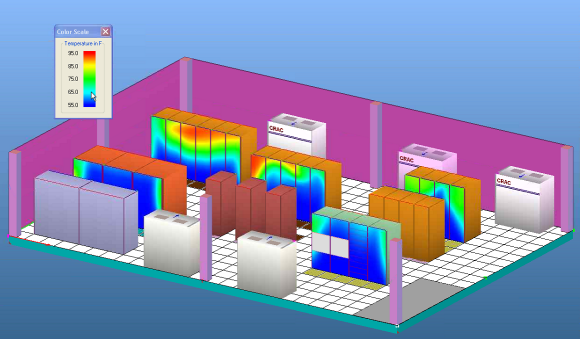How Can a Room Affect Data Center Cooling?
As data centers are increasingly focusing on lowering their PUE, more and more questions are being raised on how to bring down power consumption in a data center. Since cooling takes up a considerably large percent of the total power supplied to any data center, studies are being undertaken all over the world to churn out the most power-efficient cooling systems.
 In the process, some have even raised questions on the room specifications affecting data center cooling. Some of the frequently asked questions include: does the height of the room affect cooling? Does a larger room bring down the cooling requirements? Does a circular room demand lesser cooling? How can one even go about determining in advance how much cooling a room needs? These are some of the questions I would like to address in this article.
In the process, some have even raised questions on the room specifications affecting data center cooling. Some of the frequently asked questions include: does the height of the room affect cooling? Does a larger room bring down the cooling requirements? Does a circular room demand lesser cooling? How can one even go about determining in advance how much cooling a room needs? These are some of the questions I would like to address in this article.
First things first; no, a larger room does not imply lesser cooling. On the contrary, in a spacious room, heat gets evenly distributed. Admittedly, the hot spots or heat concentration in the room can be reduced if the equipments are more freely disturbed. This is not necessarily a positive point considering that in a large room, there is more air to be cooled. That implies that you need CRACs of higher capacity which will draw in more air and in turn, draw more power to cool the air. Also, the distance the air has to travel in order to get cooled increases in a large room; the fans have to draw more power to deliver heated air to CRAC.
It is often suggested that you arrange your equipments in a more compact setting. Hot spots can be eliminated by passing blasts of cold air to the affected area. Since you are concentrating on specific regions of the computer room that are more prone to temperature rise and not the entire room, you are bringing down the volume of air that has to be cooled to maintain the desired temperature. Thus, you are also cutting down on power for cooling costs.
If you cannot help but have a large computer room, you can try moving all the equipments to one part of the server room and block the rest of the room and remove perforated tiles and neatly close all floor openings from the blocked part of the room.
As far as possible, do try and avoid structures that can block air pathway or change the direction of airflow. In air blast techniques, cool air is concentrated on the hot spots. Any change in the direction of the air destroys the purpose of this technique. If your data center has a lot of obstructing structures, you have to find your way around the obstructions. In such cases, you can strongly consider looking into in-row cooling solutions. Since these units can be placed as close to the hot spot as possible, they are an ideal solution to cluttered environments. Alternatively, you can look into buying air-diffusers and return-air fan products.
High ceilings are usually preferred while considering space for a data center. The minimum floor to ceiling distance is 9 feet. Any addition to that height is always welcome as it gives the data center professional more space on the top to accommodate overhead cabling and also provides a pathway for heated air to the CRAC units. It also maintains enough space between the rack and the overhead sprinklers.
Saying that high ceiling guarantees power-efficient cooling is slightly far-fetched. It also depends on how the rest of the room is laid out. If the hot aisles and cold aisles are properly distanced, and a 36-inch hot aisle and a 48-inch cold aisle is provided, cooling costs can come down drastically. If hot aisles and cold aisles cannot be accommodated in the data center, it is strongly advised to have a high ceiling.
If you ensure that you stop hot air and cold air from mixing with one another, more than half you battle is won. The coolability of the room is always high when the room is rectangular in shape with very few obstructions. So if your designer wants to insert pillars in your data center or make a circular room for aesthetic purposes, you know what to say.
Data Center Talk updates its resources everyday. Visit us to know of the latest technology and standards from the data center world.
Please leave your views and comments on DCT Forum.

